Comments?
For the basics, see
- Website & Privacy Policies
- How To Get Involved
- The Role of the Park
Search options:
Department Site Map
Custodians:
Newsletter December 2019
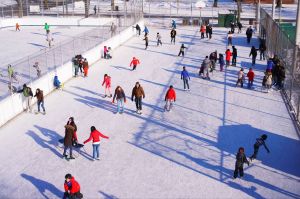 Dufferin Rink 2010 |
This newsletter is put out by CELOS, the Centre for Local Research into Public Space. Since 2000, when this little organization began at Dufferin Grove Park, we’ve been doing what we call “theoretical and practical research” into what makes public spaces – like parks – more hospitable and more lively. We’ve been researching what works and what doesn’t, and we’ve documented a lot of what we’ve seen and done, in this newsletter and on our four websites.
Goodbye to the rink as we know it
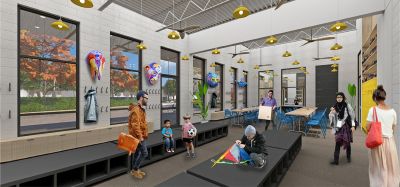
new rink change room as a day care? (2020)
This winter is the last rink season before construction begins. With strong support from City Councillor Ana Bailao, $4.5 million has been allocated to renovate the rink clubhouse, to demolish the current east/west rink pads and replace them with rink pads that face north/ south instead, and to relocate the basketball court. There was community pressure against this, including a 1062-signature petition, to keep the rink slabs as they are and use the funds to fix the whole park – not only doing long-overdue but simpler repairs to the rink clubhouse, but also building a good washroom building by the playground, better accessible paths, and better storage. But that effort did not change the city’s focus on the northwest corner.
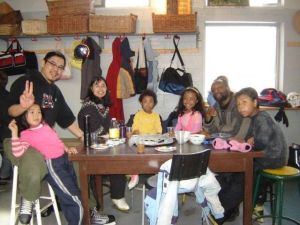
current rink change room as a clubhouse
The city’s capital projects web page says: “Construction is scheduled to begin February 2020 with an estimated completion by December 2021.” But the city’s outdoor rinks web page says the rink will stay open until March 22 (see page 3 about what happens to rinks when the sun shines in March). A later start makes a later ending likely, so that it looks like at least one and most likely the next two rink seasons will be cancelled. The rink house will be inaccessible for part or all of that time too, affecting most other park programs including the playground, the cafés, Clay and Paper Theatre, and the farmers’ market. City management staff says they will provide workarounds, but no specifics have yet been given. The city’s slide show of the transformed rink and program space is here
Sidewalk snow clearing
If you have trouble getting to the rink, the market, or anywhere else this winter because the downtown core still doesn’t get municipal sidewalk plowing (Etobicoke, North York, and Scarborough do get it), you can go to this website started by the Deer Park residents’ group to add your voice to the protest: clearoursidewalks.ca. The city has to fix this, so why not now.
Watch your stuff at the rink
During the latter half of the last rink season most lockers at Dufferin Rink were out of order, so skaters and rink visitors couldn’t secure their belongings. Not good. A little background: park friends got the city to install the lockers about 20 years ago. Even though the rink feels friendly and neighbourly, it’s a public place in a city where 2.5 million people live. Things get stolen, even for a joke – sometimes older kids thought it funny to steal shoes, for instance, forcing the unfortunate victims to walk home in their skates.
This season, in late November, city welders came and changed all the lockers over to the kind where people can bring their own combination lock. Our advice: Go and buy your own lock and bring it every time, the cost is worth it. The staff say, “just remember that you can’t keep a locker for yourself all winter.” The staff will cut the lock off if it’s left on overnight. But when you come to skate with a lock, your outing won’t be spoiled by someone stealing your stuff.
From time to time, there’s a good story connected with a theft. At the end of November, one of the rink’s cooking staff, Leslie, had put two bags on a little table in the main entryway, and she had to go to the garage to get something. She said that when she got back two minutes later, the bags were gone. One bag had a few groceries, the other one, library books. She looked everywhere in case the thief had thrown out things they didn’t want – around the park, behind the sheds, in the trash cans around the building, even in the mall’s underground garage across the street. Nothing.
The vegetables were no big thing, but the library books would cost a lot to replace. Oh dear.
The next morning, Leslie got a stern call from the library: “some books were returned after they were found on the ground in somebody’s yard on Gladstone Avenue, why were they there?” She explained about the theft.
Then she walked up Gladstone Avenue north of the rinkhouse and there, in some other yards, she found another library book, her thermos, a lunch container. No food. But two books were still missing.
Here’s the happy ending: by the next day every book that had been tossed by the thief was back in the library, no need to pay any fines. So it seems like, in this neighbourhood, if people find a library book in their front yard, even though they don’t know how it got there, they take the trouble to return it to the library. Leslie posted the story on the dufferingrovefriends listserv: “A shout out to neighbours on Gladstone! Thank you good neighbours!”
Rink literacy: how outdoor rinks work
Toronto has more outdoor mechanically-cooled rinks than any city in the world: 52. But our civic knowledge of the physics of ice maintenance hasn't kept pace with our collective rink wealth. Many people seem to find it amazing, even shocking, that outdoor rinks can be skateable when the air temperature is above freezing, as high as 11 or even 15 - during the low-sun months.
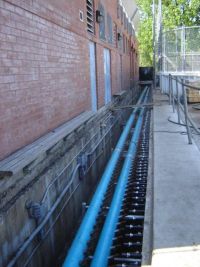
header trench at Dufferin Rink
What's the surprise? Collectively, as taxpayers, we spend more than $500 a day at each rink to fuel the machinery that cools the rink pad. The rink compressors vary between 100 and 200 horsepower each. You can hear their noise through the compressor-room doors at the sides of the buildings. At most of the rinks a brine (salt water) or glycol solution is pushed through a big tank of cooling ammonia, and then out into the extensive grid of PVC pipes underneath the concrete floor of the rink. The cold liquid brings the entire big concrete slab to well below freezing, so any water that's put on the surface of the rink pads sets up as ice right away. When the brine in the pipe grid warms up from transferring the cold to the slab, the liquid circulates back into a large pipe in the "header trench" right next to the building, underneath where everybody stands when the zamboni is doing ice maintenance. From there the brine gets pushed back into the machinery room, where it passes through the freezing-cold ammonia tank, and out again into the pipes under the concrete, and so on.
The only serious match for this powerful cooling system is the sun. In the months on either side of the December 21 winter solstice, the sun is very weak. It doesn't get to spend very much time above the horizon, and that suits the machinery just fine – when it’s below 0 Celsius outside, the compressors often cycle off. By March, though, the sun is getting much higher in the sky, and the machinery often has trouble keeping the ice frozen at minus 4. The machines have to run all the time, so in March the outdoor rinks are an energy hog.
Even on a sunny day at the end of February, even when the air temperature is minus 8, the ice gets mushy near the reflective boards, and a bit soft in the middle. The ice-making plant is losing ground as the sun prepares to bring on spring and summer. But on a low-sun day in November, even as high as 11 degrees, a thin film of water forms on top of solid ice, and the shinny hockey and pleasure-skating are brilliant.
That’s why the rink season used to be from mid-November until the first Sunday in March. Now the politicians insist that the rinks stay open until the end of March break. That’s bad energy policy.
Having all those rinks can take some of the sting out of the dark months of winter for Torontonians. But if the zamboni staff tell you that their zamboni sinks into the mush in early March, you'd better believe them -- or just take a look yourself. And tell your city councillor.
GENERAL RINK INFORMATION
Rink clubhouse: open seven days a week, Monday to Sunday: 9:00am - 9:00pm
Zamboni Café: Monday-Sunday, hours uncertain
Skate loans: $2
Shinny hockey: same hours as the rink clubhouse except Sundays. There is a (strictly enforced) age schedule. From rink staff: “If you ever see the wrong age group on the shinny ice, do us a favour and notify the rink staff right away.”
Pleasure-skating: always freely available. After 9:00pm, skating is unsupervised. Then it's a bit like skating on a pond: it’s mostly shinny hockey, and people are responsible for their own use of the rink.
The large rink lights turn off after 11:00pm, and then the rink is locked.
Parking: One good place to park is at Dufferin Mall across the street. After 5 pm. there’s lots of parking across from St.Mary’s School at the north end of the park too.
The cityrinks.ca website: This is a website run by CELOS, giving information about all 50+ municipal outdoor ice rinks, as well as Harbourfront’s Natrel Rink. The site has maps, hours, schedules, phone numbers, ratings, and stormy-weather updates. It also has blogs about the individual rinks, with contributions from skaters.
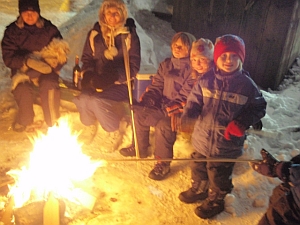
rink-side winter campfire
Winter campfires
Every year there are hundreds of campfires at Dufferin Grove Park. People like to have campfires to celebrate – birthday parties, graduations, the visit of an old friend from far away. At other times, they gather around a campfire to memorialize the passing of a grandparent, or sometimes, a son or daughter or a friend. Most of the time, campfires are simply a way to get friends and family together to enjoy one another’s company. Meantime, the sight of the campfire gives pleasure to passersby, and the “eyes on the park” by campfire participants helps the park be safer. For more information about having a wintertime rink-side campfire: 416 392-0913 or email park program staff at dufferinpark@toronto.ca. Getting a permit and a crash course on campfires is easy, and it only costs $20.
How to find out if a city outdoor rink is open
The CELOS-sponsored website CityRinks.ca tries to have current information, since the 311 outdoor rink information is often wrong. No wonder. Toronto has more municipal outdoor compressor-cooled ice rinks than any city in the world – over 50. Every time the weather changes (sometimes three times a day), ice conditions may change. That’s way too many updates to be entered into a central reporting system.
At the Ward 18 rinks, rink phone numbers continue to be unofficially available. For Dufferin Rink: 416 392-0913. For Wallace Rink: 416 392-0911. For Campbell Rink: 416 392-6921.
Neighbourhood news: A surprising twist in the Tall Towers story (Bloor and Dufferin)
On November 26, the Build a Better Bloor Dufferin (BBBD) community working group had an astonishing bit of news for the neigbourhood. The group seems to have accomplished a very gutsy piece of horse-trading. The BBBD has withdrawn its objection, at the Ontario Municipal Board, to the Bloor/Dufferin building project’s shortcomings. In exchange, the developers of the former school lands, Capital Developments and Metropia, have committed to giving a $9 million donation plus an $8 million interest-free loan for a new nonprofit land trust. It will be led by nonprofit housing providers St. Clare’s Multifaith Housing Society and Habitat for Humanity. From the BBBD newsletter:
“The land trust will enable nonprofits to acquire land for affordable housing across Toronto and the money itself will multiply as the land trust becomes a magnet for contributions from the City, the provincial and federal governments, other developers, and private foundations. In other words, the $17 million our community secured is likely to double many times over. This will give nonprofits the capacity to compete with private developers for development opportunities. We have made ground-breaking history.”
Half of the first $7 million in funds is to be used for affordable housing in Ward 9, and $2 million is for getting more spaces for non-profit services and arts organizations in the neighbourhood.
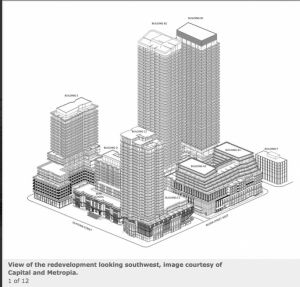
Tall towers at Bloor and Dufferin
From the BBBD:
“It’s hard to accept that the TDSB and Toronto Lands Corporation sold this land with so little regard for the needs of the community. And it’s demoralizing that after months of meetings with the City, this solution came about only as a result of BBBD’s tenacious persistence—it shouldn’t be up to volunteer community groups to ensure public benefit from multimillion-dollar developments.”
Certainly it seems that our city government was ready to let the developer go ahead as planned – a tiny park of 0.6 acres, only 56 units of the proposed 2,124 condo units being affordable housing, a community “hub” space that’s very small and has no artist and cultural spaces at all, and the loss of the BCI auditorium, the outdoor basketball courts and the playing fields.
But even without much city support, the BBBD group had a useful resource in its corner. A year ago it sought and received party standing at the Ontario Municipal Board – to challenge the Bloor/Dufferin school lands plan. The OMB hearings take a long, long time, and every day while the parties present their arguments for and against, the developers have to pay interest to their project’s investors. As delays go on, the anticipated development profits begin to shrink. Time to make a deal.
This is what can happen when neighbourhood groups across the city compare notes, which apparently they did – and when a local group’s determination outlasts the obstacles.
News release from Habitat for Humanity here.
A tip from a former bureaucrat
Many years ago, a friendly former director at Parks and Rec gave local park friends some good advice on how to make Dufferin Grove Park better in the face of many bureaucratic blocks. He said “use the rules against themselves.” Good advice. That’s not so different from what BBBD did. The “rule” of the powerful developers is to gain political support, to build their lucrative projects. That includes using the OMB and also connecting with the city government, which is hungry for more development fees plus new tax revenue. But the “rule” of long organizational delays (that also comes with using the OMB) gave the BBBD group a lever, and they used it.
Building tall towers in cities: what happens next?
From the city staff report: A minimum of 20 percent of the total residential units to be built at Bloor and Dufferin must be 2-bedroom units, and a minimum of 11 percent of the total must be 3-bedroom units. Building F will have 56 affordable bachelor and 1-bedroom units that will belong to the city. In exchange for that building the city will “give relief from development charges, planning and building permit fees and property taxes for 99 years.”
The residential units have been agreed to, and the number of storeys are: Building A: 11 storeys, Building B East: 37, Building B West: 34, Building C: 32, Building D: 19, Building E: 22, Building F: 8. Whew.
But it could be worse. Compare this with the proposed Senakw project in central Vancouver, for more than 6000 residential units in 11 towers (the tallest is 56 stories). The property is Squamish traditional land and so is not subject to most of the city planning rules.
Certainly it seems that tall towers are the direction cities are taking. And sadly, Toronto’s new laneway housing bylaw provides no counterbalance here. Bureaucratic obstacles make most downtown properties ineligible for housing infill, so that after more than a year of the bylaw, fewer than 100 laneway house permits have been approved across the city.
One of the founders of the Dufferin Grove Park skateboard group emailed a “goodbye” last week: “my wife and I have decided to throw in the towel on Toronto….. So, we are moving to Hamilton, to a 100-year-old house with a backyard and a shed, and a place for garden time.”
The neighborhood is changing, and not always for the better. Are there more ways to use the rules against themselves?
Toni Corrado is not living in the park anymore
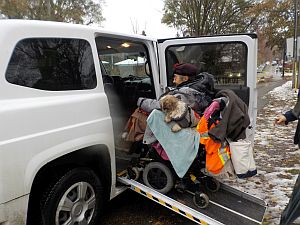
Toni on the way out of the park
At about 10 a.m. on Monday November 18, Russell from Streets to Homes pulled up with an accessible van, by appointment, beside Toni Corrado’s outdoor encampment at the cob courtyard. Brent from the Shelter, Support and Housing Administration (SSHA), had already been there since before 9, bringing Toni a coffee and helping with last minute tasks. Toni hooked a few more bags to the back of her electric wheelchair. Her two little Shi Zhu dogs, Harry Potter and Booboo, jumped up on her lap, and Toni drove her chair up the ramp into the van, to move in to her new rent-geared-to-income bachelor apartment in the east end, at last.
Toni lived outdoors in Dufferin Grove Park for three and a half months. It was warm and noisy in August, cold and rainy in the fall, there was snow on Toni’s tarps for half a week, and there were two nights of minus 13. Not an experience anyone would recommend, but it seems that clouds often have a silver lining. From Toni, the upside:
“l am grateful for all the goodness l have received....I am so happy to finally buy vegetables, eggs, cheese, bread, goodies at the Dufferin Grove farmers’ market, and bring them home.... we are having omelette tonight....plain for Harry and Boo....mine with some spinach, hot peppers. I would like to express the joy, the blessing, humanity and love Harry and Boo and l have lived in these past months at Dufferin Grove Park.....And Brent and Russell and the city’s outreach staff reached out with heart, kindness and care…”
From Toni, the downside:
“Poor Fernando [the mouse who lives in the cob wall] must miss us...gosh no squirrels, no mice, no birds , no skunks, no raccoons, no hawks, no chipmunks..... it's boring but at least l can still look out at trees from my apartment. ....No children laughing, playing, no dogs playing with Harry and Boo, no visits with friends sitting on my two chairs outside enjoying life in Dufferin Grove park. I truly miss my little community. I shall be back often.”
There are other people figuring out ways to live in the park. Most of them are not old enough to have a pension, like 71-year-old Toni has. Some are getting a disability pension. For women or trans persons the 24-hour drop-in at Sistering is a last-resort shelter in the winter, at Bloor and Dovercourt. It’s not a happy place. The June 2019 auditor’s housing report says that over 100,000 people are waiting in the lineup for rent-geared-to-income housing. Across the street from the park, at 137 Havelock, there is a privately-owned building of once-subsidized bachelor apartments, standing empty now for over ten years.
People want a room of their own. How to get more of those is the big question.
Editor: Jutta Mason/ Illustrations: Jane LowBeer
CELOS websites: dufferinpark.ca, celos.ca, cityrinks.ca, publicbakeovens.ca




 Printer friendly version
Printer friendly version